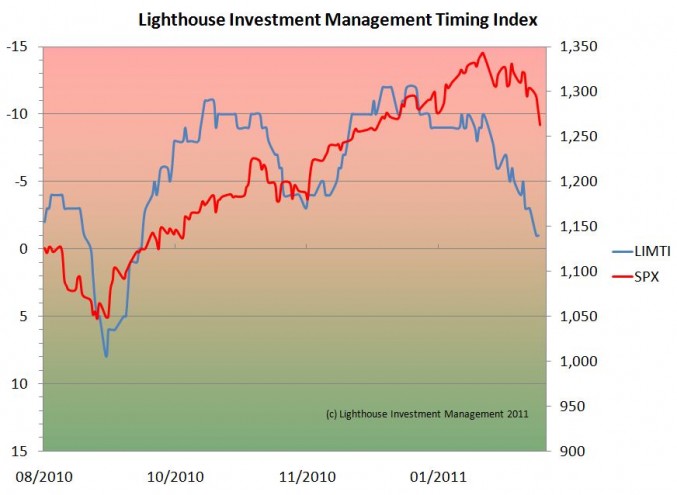The earthquake and nuclear situation in Japan has triggered a sell-off in the equity markets. Is this a buying opportunity?
I say “no”. Two reasons:
1. The Japanese situation is likely to trigger many “unintended” consequences we cannot anticipate right now (for example a strong Yen will hurt profits of Japanese exporters, hence depress their share price). Disruptions from the earthquake will be cited by companies as an excuse for earnings misses throughout the year (“our supplier couldn’t deliver”).
2. The Lighthouse Investment Management Timing Index (LIMTI) has barely moved back to “neutral”. After a 100% move over two years, a 7% drop does not “cure” the overbought situation.
We will continue to hold our position in inverse ETF on SPY (SH). We will take delivery in a gold mining stock ETF (GDX) via short put options this Friday. Volatilities are high, so we might write calls on that on a strong day.
All eyes on QE3
QE, or “Quantitative Easing” (a euphemism for printing money), is the lifeline of the economy (and stock market). The “real” printing is done by Congress (spending exceeds tax revenue), but the Fed is complicit in absorbing a large part of the treasury bonds needed to finance the deficit.
So what will happen at the end of June? The Fed said they would purchase $75bn a month through the second quarter. Economists quickly calculated $75bn x 8 months = $600bn. But you have to read exactly what the Fed says. They don’t say we will buy $600bn until June and then stop. Their wording leaves the door open to 2 scenarios:
a) The Fed, probably at the next FOMC meeting, says “Hey – we never said we are going to stop” and will continue monetizing $75bn per month “until no longer needed” (read: eternity), or
b) The Fed says “no QE3, but we will re-invest interest and redemptions”. Since they will own roughly $3trn in assets, they might have $750bn of money coming in per year. This would be enough to absorb approximately 75% of the issuance in 2-10 year Treasury bonds.
Scenario a) would only be possible if the stock market has a serious set back and scares everybody into the open arms of the Fed. Since the threat of deflation has significantly decreased (even in the eyes of the Fed) the justification for QE3 seems to stand on thin legs. Political support might be limited.
But as shown above, the Fed doesn’t “need” a QE3 to continue to monetize a large part of debt issuance. This means carte blanche for Congress to keep running large deficits. This means continued supply of fresh dollars, and debasement of the currency.
The gold and silver markets will love it.
The question is: gold or silver? Silver had a huge run (+100% since last summer), and the market is less manipulated by central banks (they are the largest holders of gold). A large part of investment demand for precious metals has been absorbed by “paper” gold (GLD) and silver (SLV), and hence did not translate into “physical” demand.
I recommend to stay away from “paper” gold and silver. Those ETF’s have counter-party risk as some of their assets exist only in form of a derivative trade.
There are some “physical trusts” (PHYS, PSLV) that claim to have segregated their bars at the Royal Mint of Canada and offer the opportunity to exchange shares into physical metal once a month, but they trade at a premium to net asset value of up to 20% (PSLV).
That leaves gold and silver mining stocks (apart from having metal at one’s home or bank). Individual companies might be too risky. But there are ETF’s representing a basket of gold (GDX) and silver (SIL) mining companies.
We will try to “leg” into those stocks on days where panic rips through the markets.

